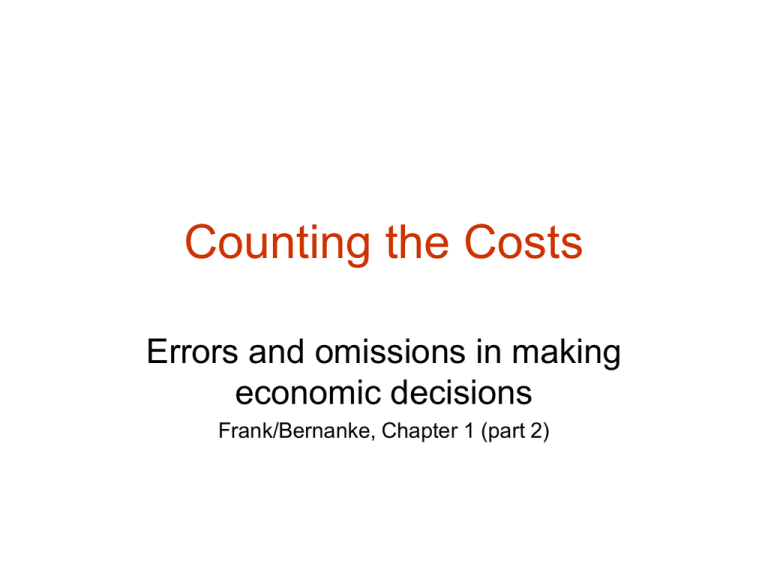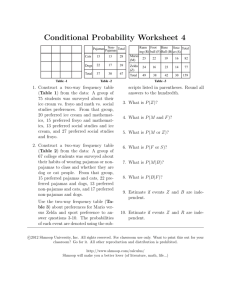Counting the Costs
advertisement

Counting the Costs Errors and omissions in making economic decisions Frank/Bernanke, Chapter 1 (part 2) Error 1: Forgetting opportunity costs The economic cost of an action includes the cost of opportunities not taken: -- the cost of college includes not only tuition, but also wages not collected because of the job not taken. -- the cost to GM of manufacturing more SUVs includes not only the price of steel and plastic and glass, but the profit not made on sedans which were not produced. Example: the Wallflowers and the Wilburys (Frank, ch.1, prob. 10 -- modified) Wallflowers are giving a free concert; the Wilburys are giving a concert which will cost $8 on the same night. You prefer the Wilburys; your reservation price for hearing their concert (if you had no other option) is $12. What is the cost of hearing the Wallflowers? Their concert is free, but going to it means giving up the opportunity to hear the Wilburys and gain $ 4 of economic surplus ($12 reservation price - $ 8 cost) Go to the Wallflowers only if you value their concert at more than $4, the value of the opportunity foregone. Kwame Nkrumah the Decision Maker Soap …? Selling Ghana’s soap: http://www.island.net/~ydrums/black.htm … or cocoa? Example: interest on loans • Interest on loans is often regarded as unfair – • Aristotle found it “unnatural” • In the Middle Ages, it was labeled “usury” and regarded as sinful. • Most countries still maintain “usury laws” limiting the amount of interest that can be charged. • • http://www.time.com/time/europe/biz/magazine/0,9868,99926,00.html Note that there is an economic justification for some limits on the rate of interest: see from the University of Bari: http://www.dse.uniba.it/Seminari/CocoDemeza.htm Interest and opportunity cost • The opportunity cost argument for interest is simple: if you loan money to anyone, you give up the opportunity to invest it productively. • “wherever a great deal can be made by the use of money, a great deal will commonly be given for the use of it” – Adam Smith, Wealth of Nations, (Book I, ch. 9, p. 90 of Cannan edition) • Hence, “in our North American and West Indian colonies, not only the wages of labour, but the interest of money, and consequently the profits of stock, are higher than in England” (p. 94) Mike the Mushroom Farmer • Mike knows that if he invests his spare cash in mushrooms, he can make a profit of 20 percent at the end of one year, and expects the price to remain constant. • If Zoe asks Mike for a loan of $10,000, she should not be surprised to be asked to pay 20 percent interest – Mike is giving up the opportunity to make that much profit. • In practice, adjustments will be made for the risk that the loan is not repaid (“risk premium”), and for the risk that mushroom price will fall. Error 2: considering “sunk costs” • “Sunk costs” or “fixed costs” are costs which will be incurred whether or not an action is taken. • They should be ignored in deciding on a course of action. • If you’ve bought the (non-refundable) ticket to the football game, should you attend during a blizzard? Your answer should be the same as if you were given the ticket for free. Fixed and Variable Costs • If you own a car, you have to pay: – Fixed costs such as loan payments and insurance – Variable costs such as gasoline, new tires (the old ones wear out only if the car is driven) – The decision about whether to take a trip should be based on the variable costs alone, since these are the only costs that will change if you take the trip. Average and marginal costs • The fixed/variable distinction is closely related to the average/marginal distinction. • Total costs = Fixed costs plus variable costs. • Average cost = Total cost divided by number of units of a good (or level of activity). • Marginal cost = Change in variable cost resulting from one more unit of a good (or an increase in the level of an activity). – Note that the definition could have said “Change in total cost…”, since variable costs are the only ones that change. The Pajama Game The musical did have an economic theme – a dispute over a wage increase of seven and a half cents. Here, we assume you are the manager, worried about: 1. How to pay the interest on the money you borrowed to build the pajama factory. 2. How to keep track of the costs of producing pajamas. http://www.sonymusic.com/clips/selection/30/089253/089253_01_02_30.wav Click above for the title song. TC = 10000 + 5 Q • The above cost equation is a way of tying together the different cost concepts. • Total cost = Fixed cost + variable cost • The 10,000 is fixed – you will pay $ 10,000 whether or not you produce a single pair of pajamas (interest on loans to build plant) • The 5 Q term varies with quantity – you will pay another $ 5 for each pair of pajamas you produce (for cloth, buttons, labor) Average cost • Average cost = Total cost divided by Quantity • If Q = 1000, TC = 10,000 + 5 (1,000) or TC = $15,000 • If Q = 1,000 then AC = $ 15,000 divided by 1000, or Average Cost = $ 15.00. • Repeat for Q = 2000, to find • TC (at 2000) = 10,000 + 5 (2,000) = $ 20,000 • AC (at 2000) = $ 20,000 divided by 2,000 or average cost = $ 10.00 • Note that average cost decreases with output Variable and Marginal Cost • Total Cost = 10,000 + 5 Q • Fixed cost = 10,000 (doesn’t change with Q) • Variable cost = 5 Q (increases when Q increases) • Marginal cost = $ 5 – Every EXTRA unit of production means an EXTRA cost of $ 5. – Note that in this case marginal cost does not increase with quantity. Graph of total cost Costs ($) Total Cost = 10,000 + 5 Q Fixed cost = 10,000 $ 10,000 1000 2000 Pajamas Graph of total cost Costs ($) Total Cost = 10,000 + 5 Q $20,000 $15,000 Fixed cost = 10,000 $ 10,000 1000 2000 Pajamas Graph of total cost Costs ($) Total Cost = 10,000 + 5 Q $20,000 $15,000 Fixed cost = 10,000 $ 10,000 1000 2000 Pajamas







